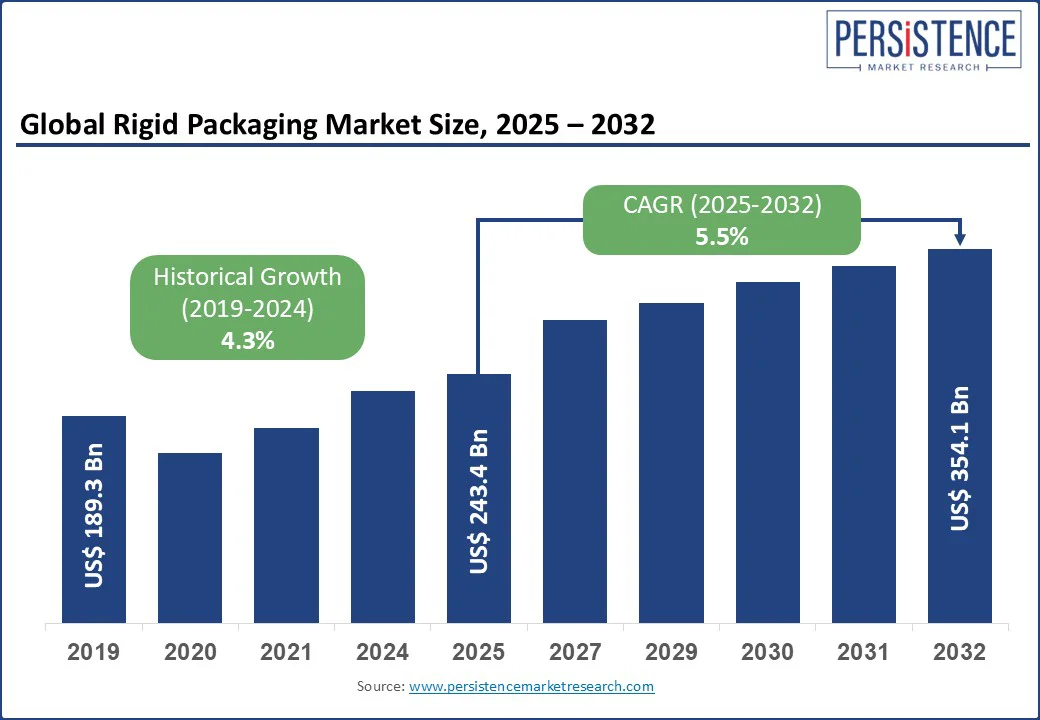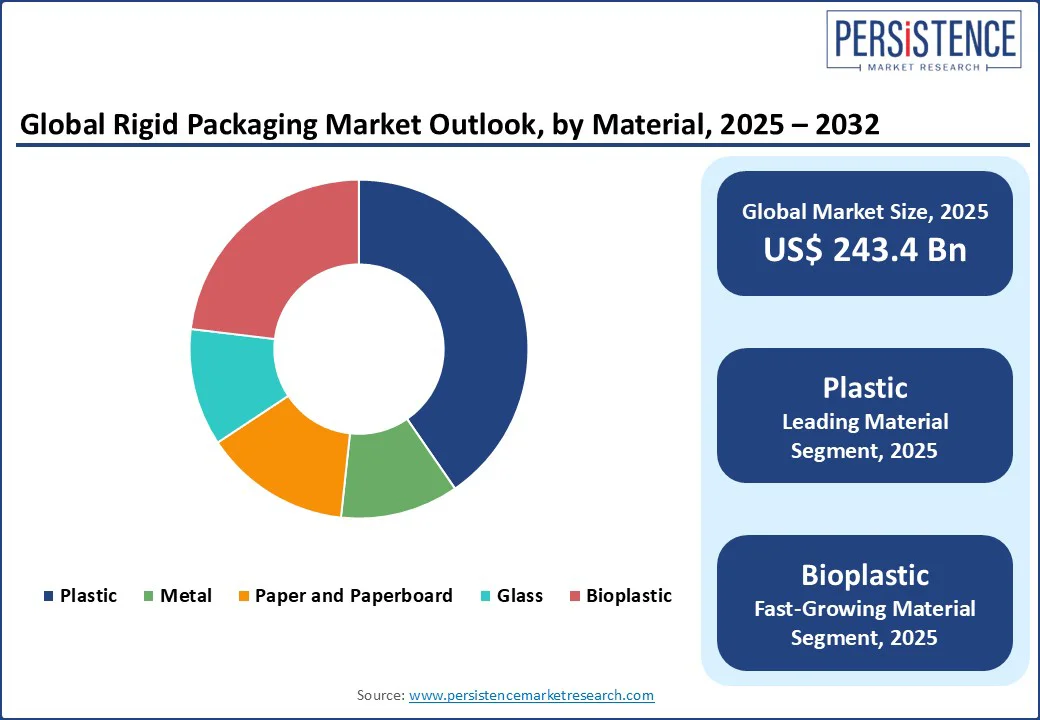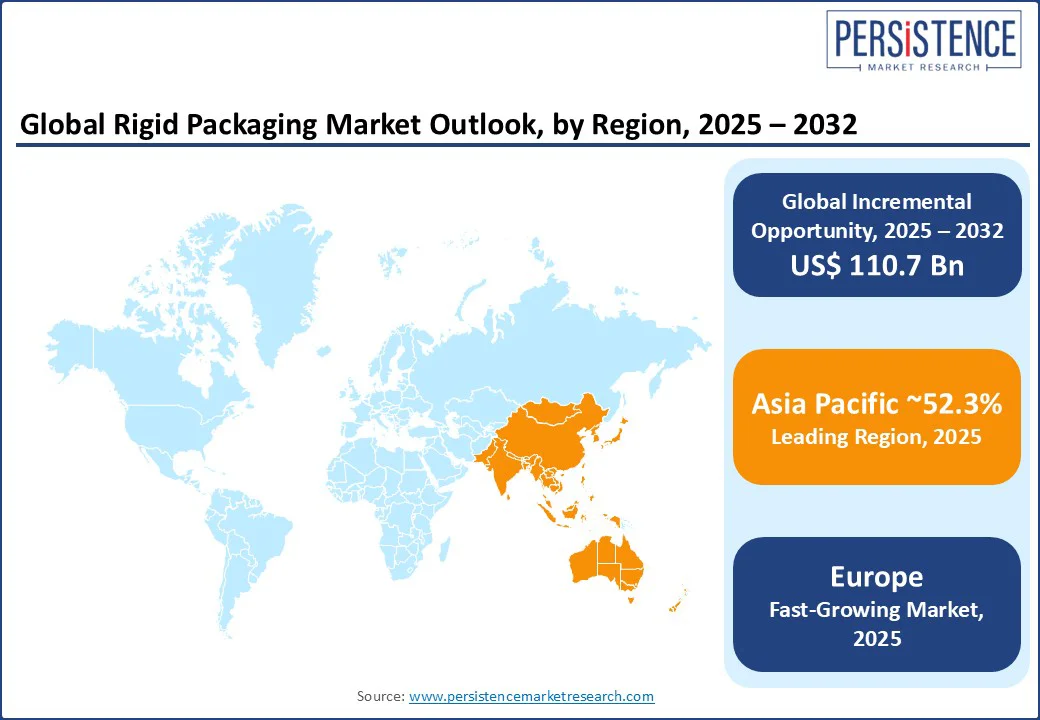ID: PMRREP4084| 199 Pages | 1 Aug 2025 | Format: PDF, Excel, PPT* | Packaging

The rigid packaging market size is likely to be valued at US$ 243.4 Bn in 2025 and is estimated to reach US$ 354.1 Bn in 2032, growing at a CAGR of 5.5% during the forecast period 2025-2032. Rigid packaging has emerged as a key to modern supply chain efficiency, brand positioning, and regulatory compliance across various industries. Characterized by its structural integrity and durability, rigid packaging formats are favored for their ability to protect product quality throughout extended distribution cycles. In addition, the rising demand from food, pharmaceuticals, and personal care sectors, as well as the surge of automation in warehousing and retail fuels growth. Key market players are using rigid formats not only for functional advantages but also to comply with evolving sustainability mandates.

Key Industry Highlights
|
Global Market Attribute |
Key Insights |
|
Rigid Packaging Market Size (2025E) |
US$ 243.4 Bn |
|
Market Value Forecast (2032F) |
US$ 354.1 Bn |
|
Projected Growth (CAGR 2025 to 2032) |
5.5% |
|
Historical Market Growth (CAGR 2019 to 2024) |
4.3% |
Increasing consumption of ready-to-eat (RTE) food, including potato chips, bread, and sausages, is propelling the rigid packaging market growth. This is attributed to the packaging’s ability to preserve product integrity, extend shelf life, and deliver tamper-resistant formats. The RTE food market is primarily influenced by the increasing number of small households and surging working professionals globally. These foods require durable packaging solutions that can withstand handling during transportation and retail display. Hence, the demand for rigid plastic trays, tubs, and clamshells is skyrocketing.
Sausages, for instance, are now sold in thermoformed rigid plastic packs with Modified Atmosphere Packaging (MAP) that helps control microbial growth and preserve freshness. Companies such as Johnsonville and Oscar Mayer have transitioned to clear PET-based rigid trays with high barrier films, improving visibility while ensuring food safety. Similarly, potato chips manufacturers, including Lay’s and Pringles, use rigid composite cans and molded trays to prevent breakage and maintain crispness.
Rigid packaging’s limitations in protecting fragile items are prompting manufacturers in electronics, luxury goods, and glassware sectors to choose alternatives such as foam inserts, molded pulp, and cushioned flexible packaging. In the consumer electronics segment, for example, Apple and Samsung have shifted toward molded fiber or paper-based cushioning solutions that not only reduce product damage but also help meet sustainability goals. This shift is augmented by the inadequacy of rigid formats in ensuring adequate drop resistance and product immobilization. It is evident in e-commerce logistics where handling conditions are unpredictable.
Cost is another key hindrance. Rigid packaging made from PET, HDPE, or metal involves higher raw material and processing expenses compared to flexible packaging. As per a 2024 online study, rigid plastic containers can cost 25 to 40% more per unit than equivalent flexible pouches, depending on the complexity of the design and material grade. This cost discrepancy becomes prohibitive for companies operating in highly competitive and price-sensitive markets. Hence, companies focusing on enhancing logistics or cutting carbon emissions are avoiding rigid formats in favor of lightweight and low-volume alternatives.
The shift toward a centralized structure in grocery retailing is creating new opportunities for rigid packaging manufacturers. It is helping to improve supply chains and support demand for packaging formats that provide durability, stackability, and extended shelf life. Centralized distribution hubs used by key retailers such as Walmart, Tesco, and Reliance Fresh now handle high-volume, multi-SKU shipments. These make rigid containers ideal due to their uniform shapes and resistance to crushing during bulk transport. It has resulted in the surging use of standardized rigid crates, PET jars, and thermoformed trays that reduce product damage.
Retailers are also investing in private-label products across dairy, bakery, sauces, and ready meals. These often depend on rigid packaging to ensure product integrity and visual appeal. The centralization trend also supports novel inventory forecasting and automation, prompting retailers to favor packaging formats compatible with robotic picking. Rigid formats such as injection-molded HDPE and PP containers deliver dimensional consistency, making these suitable for machine handling.
Based on material, the market is divided into plastic, metal, paper and paperboard, glass, and bioplastic. Out of these, plastic will likely account for approximately 40.4% of the rigid packaging market share in 2025 due to its exceptional versatility in design, cost-effectiveness, and superior barrier properties. Rigid plastics such as PET, HDPE, and PP offer high impact resistance while being lightweight, which reduces transportation costs and breakage risks. Key FMCG brands continue to rely heavily on rigid plastic tubs, jars, and bottles for products such as coffee, spreads, and shampoos. This is because they deliver precision molding, resealability, and stackability features that improve both user experience and shelf display.
Bioplastic rigid packaging is gaining traction owing to increasing regulatory pressure and brand commitments to phase out fossil-based plastics. The European Union’s Single-Use Plastics Directive and California’s SB 54 Plastic Pollution Prevention and Packaging Producer Responsibility Act have created clear mandates for compostable or bio-based alternatives. In response, companies are turning to bioplastics such as polylactic acid (PLA) and polyhydroxyalkanoates (PHA) for rigid applications in foodservice, cosmetics, and electronics.
By application, the market is segregated into food, beverages, pharmaceuticals and healthcare, personal care and cosmetics, automotive, building and construction, and others. Among these, the food segment is projected to hold around 27.8% of share in 2025, backed by evolving consumer preferences toward convenience, safety, and portion-controlled packaging. Rigid packaging formats such as trays, tubs, bottles, and clamshells have gained momentum due to their ability to preserve freshness and resist external contamination. The rise in chilled ready meals, dairy products, and snack foods has further accelerated demand for rigid formats that help endure refrigeration, stacking, and transport without deforming.
The pharmaceutical and healthcare industry is predicted to hold a considerable share in 2025, owing to strict safety, hygiene, and regulatory compliance requirements that demand tamper-evident packaging solutions. Rigid formats such as HDPE bottles, blister packs, and polypropylene vials offer superior protection against moisture, oxygen, and physical damage. It is important for sensitive products, including biologics, injectables, and over-the-counter (OTC) medications. With the surge in biologics and personalized medicines, there has also been a shift toward high-barrier rigid containers that support cold chain logistics and aseptic filling.

Sustainability mandates, premiumization trends, and the rise of private-label products are pushing the market in North America. The U.S. rigid packaging market is seeing steady growth as regulatory pressures, including California’s SB 54, are boosting the adoption of recyclable and PCR-based rigid materials. In 2021, Coca-Cola North America, for example, began rolling out 100% rPET rigid bottles for several product lines across California and New York.
Premiumization of packaging is further gaining momentum, specifically in beverages, cosmetics, and specialty food. Brands such as La Colombe and Olipop are using sleek aluminum and rigid glass containers not just for shelf appeal but also to increase perceived product value. La Colombe’s ready-to-drink coffee in rigid aluminum bottles has doubled its retail presence across North America since 2022. This trend is strengthened by consumer demand for upscale and reusable formats in categories such as cold brews, nut butters, and haircare products.
Europe’s market is being augmented by strict environmental regulations, consumer demand for sustainable formats, and development in recycling technologies. Germany leads in terms of volume due to unique collection systems and regulatory frameworks that support high recycling rates. France is also moving steadily with its Anti-Waste and Circular Economy Law, aiming to recycle all plastics by 2025 and eliminate single-use plastics by 2040. These national mandates are imposing a move toward rigid mono-material formats that fit in Europe’s recycling infrastructure.
The food and beverage segment remains the most prominent user of rigid packaging in the region. Ready meals, dairy, sauces, and beverages continue to shift toward thin-walled PET containers and CPET trays that are microwave-compatible, lightweight, and recyclable. Brands are responding to rising consumer pressure by expanding closed-loop recycling systems for PET trays. These circular supply chains are helping them comply with EU rules that mandate all packaging to be recyclable or reusable by 2030.
In 2025, Asia Pacific is anticipated to account for nearly 52.3% of share due to the ongoing expansion of organized retail and e-commerce. China and India are poised to remain at the forefront owing to high consumption of packaged foods, beverages, and personal care products. China’s rigid packaging segment saw increased adoption of PET and HDPE bottles in functional beverages and nutraceuticals. Brands such as Genki Forest and Nongfu Spring are investing in lightweight and recyclable PET bottles to meet both performance and sustainability goals.
India is witnessing a surging use of rigid plastic containers, specifically for edible oils, dairy products, and condiments. Indonesia and Vietnam are also shifting toward rigid formats mainly in bottled water, cooking sauces, and single-serve meals categories that require durable as well as tamper-resistant packaging to appeal to young consumers. Japan and South Korea are pushing growth in the field of bio-based rigid packaging. Recently, Japan-based retailer Aeon, for instance, introduced a rigid PLA-based container range for ready-to-eat meals in its Tokyo outlets to lower the use of single-use plastics and promote sustainable packaging options.

The rigid packaging market houses various large multinational corporations and regional players, with intense competition spurred by price, restructuring, and sustainability credentials. Key players are moving toward diversified product portfolios and long-term contracts with leading FMCG, pharmaceutical, and industrial clients to compete in the market. They are investing huge sums in unique rigid packaging solutions such as lightweight designs and recyclable or PCR content to comply with changing regulatory preferences. Regional players are competing on the basis of cost and customization, primarily in developing economies, where demand for affordable rigid packaging is increasing.
The rigid packaging market is projected to reach US$ 243.4 Bn in 2025.
Rising demand for durable packaging and the growth of e-commerce are the key market drivers.
The rigid packaging market is poised to witness a CAGR of 5.5% from 2025 to 2032.
Ongoing expansion of the FMCG sector and surging preference for personalized packaging are the key market opportunities.
Bemis Company, Inc., Amcor Limited, and Coveris Holdings S.A are a few key market players.
|
Report Attribute |
Details |
|
Historical Data/Actuals |
2019 - 2024 |
|
Forecast Period |
2025 - 2032 |
|
Market Analysis |
Value: US$ Bn/Mn, Volume: As Applicable |
|
Geographical Coverage |
|
|
Segmental Coverage |
|
|
Competitive Analysis |
|
|
Report Highlights |
|
|
Customization and Pricing |
Available upon request |
By Material
By Product Type
By Application
By Region
Delivery Timelines
For more information on this report and its delivery timelines please get in touch with our sales team.
About Author